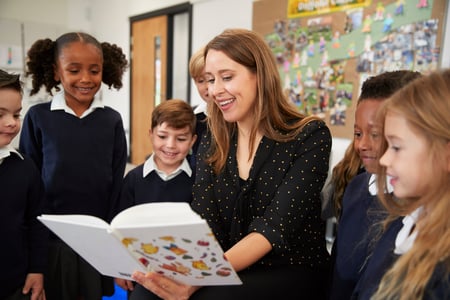
I’ve been working with my colleague, Sarah Hadden, to put together a new Implementation Guide (coming later this summer), along with some resources for groups writing early childhood grants. Below is an excerpt—slightly modified for blog-post purposes—from the Implementation Guide section on improving teacher-child interactions. Let me know what you think!
Our Professional Development Programs

Research on improving teacher-child interactions suggests that, to make real improvements, teachers need to know, see, and do.[1] In other words, they need to:
- Understand what effective interactions are (know)
- Become more aware of their own interactions with children and the opportunities that these interactions afford (see)
- Use more effective interactions to get the most out of every moment (do)
Knowledge can be increased through trainings or workshops, but increasing knowledge is only one piece of a broader comprehensive strategy. To really make changes, teachers also need support and strategies to put their knowledge into action; and becoming more aware of their interactions in the moment can help bridge the gap between knowing and doing.
At Teachstone, we have built our professional development offerings around this research. They include coach supports to build your program’s capacity for change as well as online programs to help teachers know, see, and do more effective interactions.
MyTeachingPartner™ Coaching was developed by researchers at the University of Virginia. It is a structured coaching program in which teachers work one-on-one with a coach over a 10-month period. Every two weeks, a teacher uploads a video of his or her own teaching for the coach to review. The coach asks the teacher to focus on specific aspects of each video and together they discuss the effective and ineffective interactions that took place. Over the 10-month program, the coach encourages the teacher to improve the effectiveness of his or her interactions with students.
In a randomized controlled trial, participation in MTP Coaching led to significant gains in teacher-student interactions in all three CLASS domains.[2] Furthermore, children in the MTP classrooms made greater language and literacy gains compared to children in the control group.[3
Our CLASS-based course, Making the Most of Classroom Interactions (MMCI), is based on research proving the effectiveness of coursework in improving interactions. In a study, researchers developed a college-style course focused on teacher-child interactions along with language and literacy instruction. In a randomized controlled trial, researchers found that the course improved teacher-child interactions significantly in Emotional Support and Instructional Support.[4] Teachstone’s MMCI course is a 10-session program focused exclusively on teacher-child interactions. It gives teachers opportunities to analyze and discuss interactions in each Pre-K CLASS dimension, as well as homework assignments to help them apply their new skills in the classroom.
The Instructional Support Strategies training for coaches, available as a one-day training or an online series, responds to a strong demand for more help in the Instructional Support domain. Coaches learn research-based approaches for helping teachers deepen their Instructional Support interactions and leave with concrete, tested strategies for improvement.
Our online resources for teachers, including Looking at CLASSrooms and the CLASS Video Library, were developed based on research showing that teachers who engage with video exemplars improve their interactions.[5] The CLASS Video Library provides brief videos of effective teacher-child interactions within each CLASS dimension. Focus text for each video draws teachers’ attention to the relevant interactions. Looking at CLASSrooms provides teachers with a guided walk through the video library, with units that encourage teachers to spend time with the videos and explore each dimension.
The CLASS Discussion Toolkit is based on evidence that group involvement in professional development can boost its effectiveness.[6] The Toolkit encourages teachers to view and analyze videos of teacher-child interactions and discuss how they bring each dimension into their own classroom practice.
Our new Implementation Guide will cover lots of questions related to when, how, and why to use the CLASS for evaluation and professional development. Do you have questions you’d like to see answered? Email me or leave a comment below. And if you’re working on an Early Head Start Expansion and EHS Child Care Partnership Grant, read this recent blog post by Rebecca Berlin, and check back on our website for more resources as they become available.
Notes
1. Pianta, R. C., Burchinal, M., Jamil, F. M., Sabol, T., Grimm, K., Hamre, B. K., … & Howes, C. (2014). A cross-lag analysis of longitudinal associations between preschool teachers’ instructional support identification skills and observed behavior, Early Childhood Research Quarterly, 29, 144-154.
2. Pianta, R. C., Mashburn, A. J., Downer, J. T., Hamre, B. K., & Justice, L. (2008). Effects of web-mediated professional development resources on teacher-child interactions in pre-kindergarten classrooms. Early Childhood Research Quarterly, 23(4), 431–451.
3. Mashburn, A., Downer, J., Hamre, B., Justice, L., & Pianta, R. (2010). Consultation for teachers and children’s language and literacy development during pre-kindergarten. Applied Developmental Science, 14(4), 179–196.
4. Hamre, B. K., Pianta, R. C., Burchinal, M., Field, S., LoCasale-Crouch, J., Downer, J. T., ...Scott-Little, C. (2012). A course on effective teacher-child interactions: Effects on teacher beliefs, knowledge, and observed practice. American Educational Research Journal, 49, 88-123.
5. Pianta, R. C., Mashburn, A. J., Downer, J. T., Hamre, B. K., & Justice, L. (2008). Effects of web-mediated professional development resources on teacher-child interactions in pre-kindergarten classrooms. Early Childhood Research Quarterly, 23(4), 431–451.
6. Gersten, R., Dimino, J., Jayanthi, M., Kim, J. S., & Santoro, L. E. (2010). Teacher Study Group: Impact of the professional development model on reading instruction and student outcomes in first grade classrooms. American Educational Research Journal, 47, 694-739.

